2006 MAZDA MODEL 6 SPORT WAGON battery
[x] Cancel search: batteryPage 263 of 390
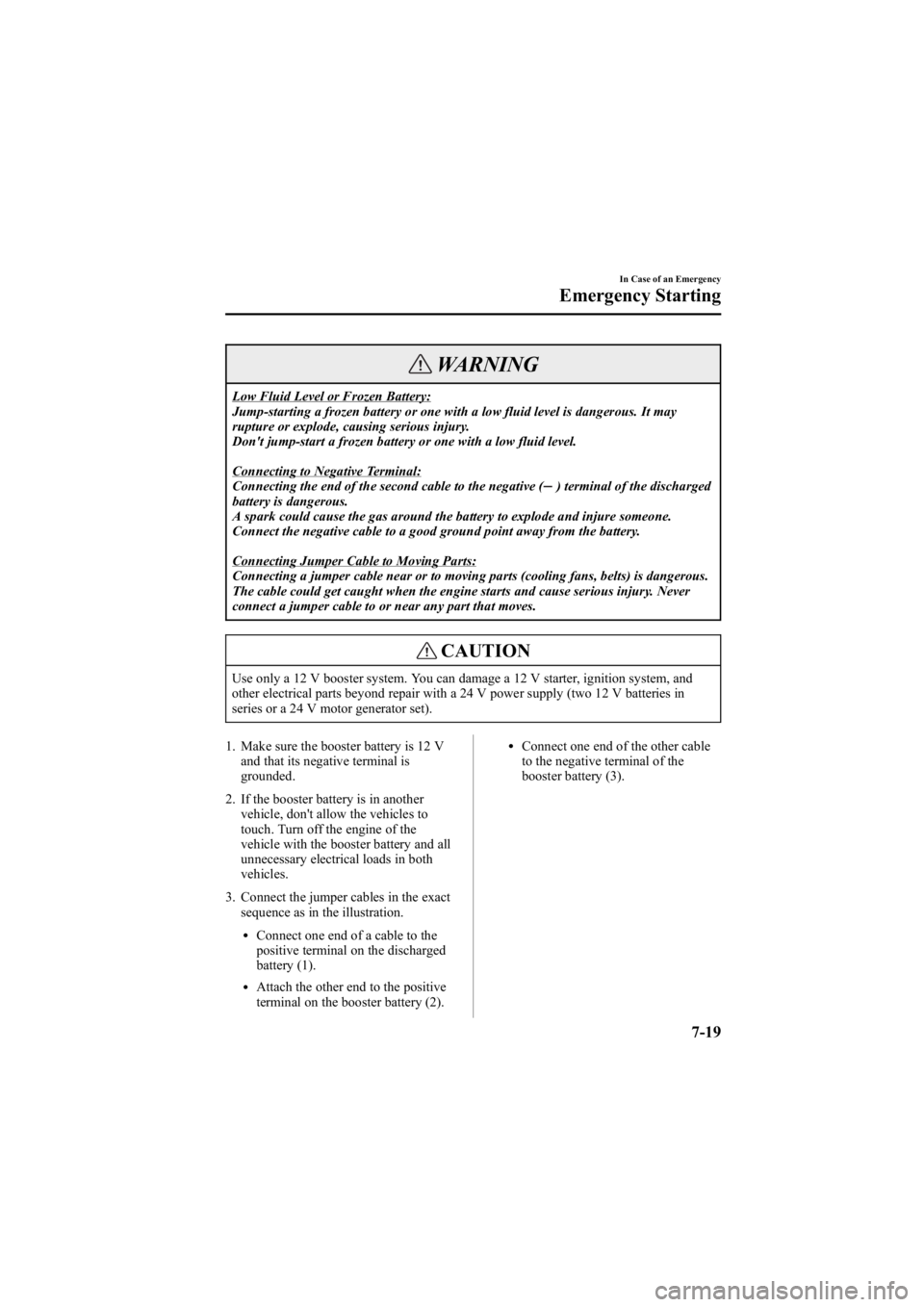
Black plate (263,1)
WARNING
Low Fluid Level or Frozen Battery:
Jump-starting a frozen battery or one with a low fluid level is dangerous. It may
rupture or explode, causing serious injury.
Don't jump-start a frozen battery or one with a low fluid level.
Connecting to Negative Terminal:
Connecting the end of the second cable to the negative () terminal of the discharged
battery is dangerous.
A spark could cause the gas around the battery to explode and injure someone.
Connect the negative cable to a good ground point away from the battery.
Connecting Jumper Cable to Moving Parts:
Connecting a jumper cable near or to moving parts (cooling fans, belts) is dangerous.
The cable could get caught when the engine starts and cause serious injury. Never
connect a jumper cable to or near any part that moves.
CAUTION
Use only a 12 V booster system. You can damage a 12 V starter, ignition system, and
other electrical parts beyond repair with a 24 V power supply (two 12 V batteries in
series or a 24 V motor generator set).
1. Make sure the booster battery is 12 V and that its negative terminal is
grounded.
2. If the booster battery is in another vehicle, don't allow the vehicles to
touch. Turn off the engine of the
vehicle with the booster battery and all
unnecessary electrical loads in both
vehicles.
3. Connect the jumper cables in the exact sequence as in the illustration.
lConnect one end of a cable to the
positive terminal on the discharged
battery (1).
lAttach the other end to the positive
terminal on the booster battery (2).
lConnect one end of the other cable
to the negative terminal of the
booster battery (3).
In Case of an Emergency
Emergency Starting
7-19
Mazda6_8V40-EA-05L_Edition1 Page263
Monday, November 28 2005 6:10 PM
Form No.8V40-EA-05L
Page 264 of 390
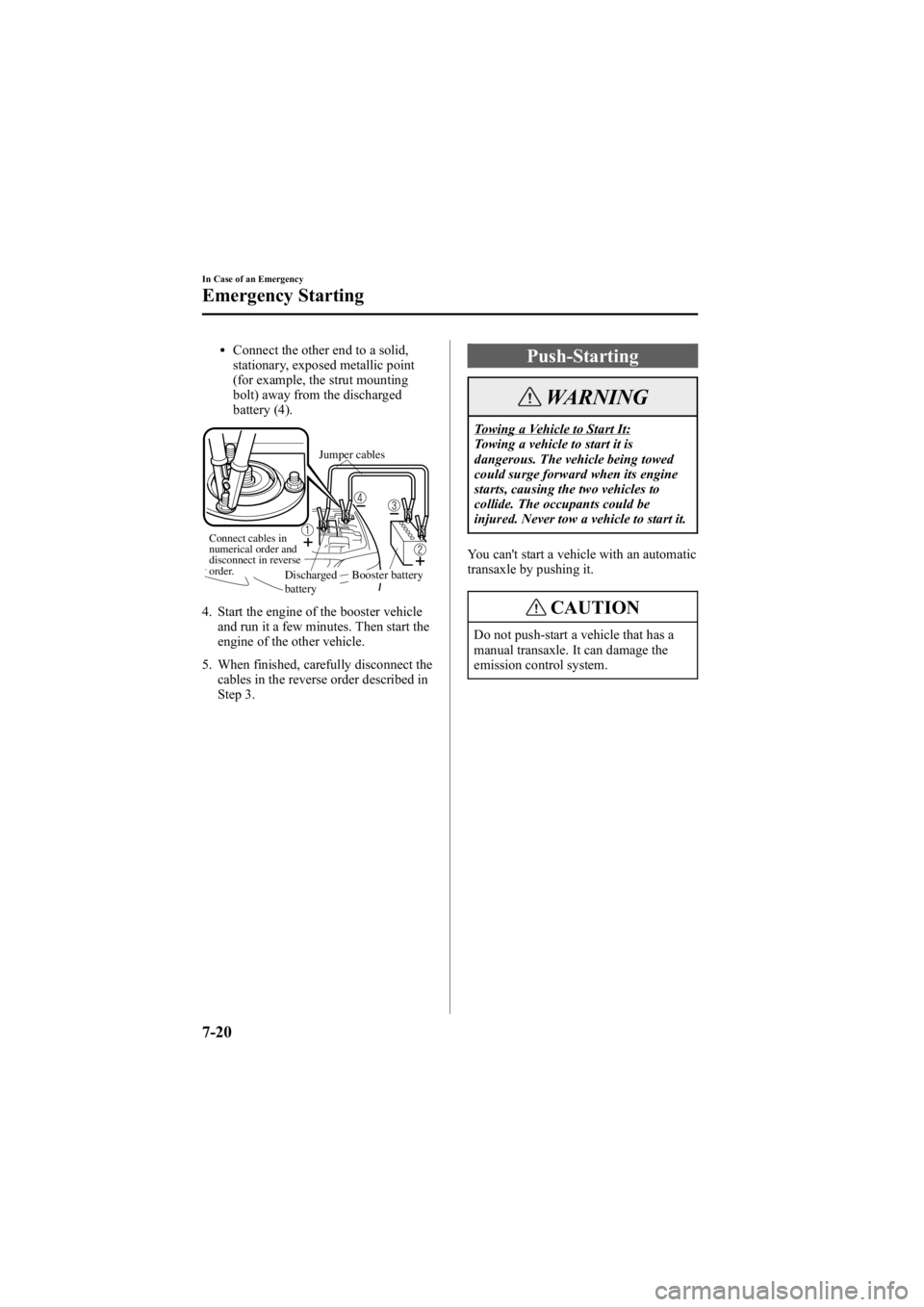
Black plate (264,1)
lConnect the other end to a solid,
stationary, exposed metallic point
(for example, the strut mounting
bolt) away from the discharged
battery (4).
Connect cables in
numerical order and
disconnect in reverse
order.
Discharged
batteryJumper cables
Booster battery
4. Start the engine of the booster vehicleand run it a few minutes. Then start the
engine of the other vehicle.
5. When finished, carefully disconnect the cables in the reverse order described in
Step 3.
Push-Starting
WARNING
Towing a Vehicle to Start It:
Towing a vehicle to start it is
dangerous. The vehicle being towed
could surge forward when its engine
starts, causing the two vehicles to
collide. The occupants could be
injured. Never tow a vehicle to start it.
You can't start a vehicle with an automatic
transaxle by pushing it.
CAUTION
Do not push-start a vehicle that has a
manual transaxle. It can damage the
emission control system.
7-20
In Case of an Emergency
Emergency Starting
Mazda6_8V40-EA-05L_Edition1 Page264
Monday, November 28 2005 6:10 PM
Form No.8V40-EA-05L
Page 267 of 390
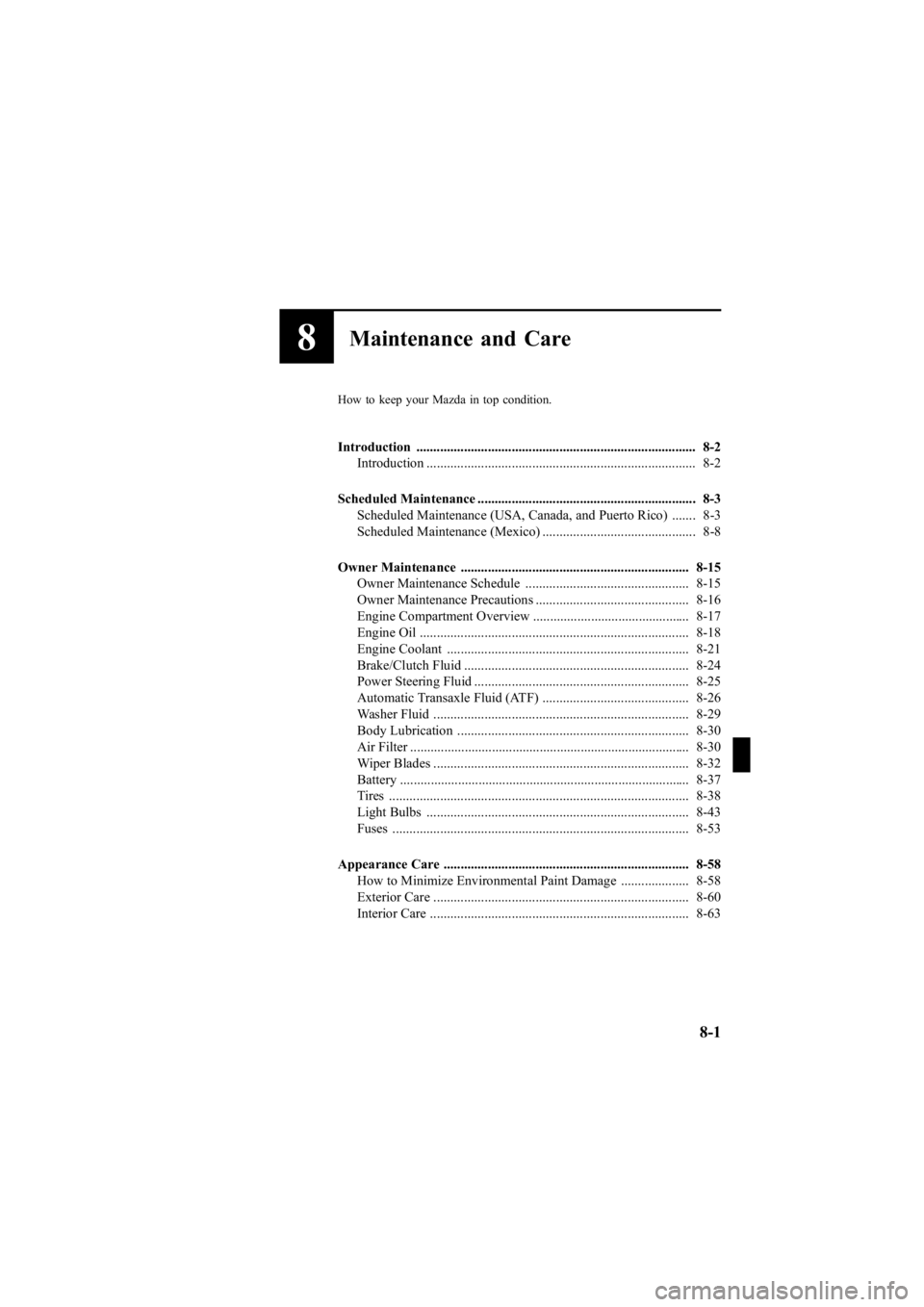
Black plate (267,1)
8Maintenance and Care
How to keep your Mazda in top condition.
Introduction .................................................................................. 8-2Introduction ............................................................................... 8-2
Scheduled Maintenance ................................................................ 8-3 Scheduled Maintenance (USA, Canada, and Puerto Rico) ....... 8-3
Scheduled Maintenance (Mexico) ............................................. 8-8
Owner Maintenance ................................................................... 8-15 Owner Maintenance Schedule ................................................ 8-15
Owner Maintenance Precautions ............................................. 8-16
Engine Compartment Overview .............................................. 8-17
Engine Oil ............................................................................... 8-18
Engine Coolant ....................................................................... 8-21
Brake/Clutch Fluid .................................................................. 8-24
Power Steering Fluid ............................................................... 8-25
Automatic Transaxle Fluid (ATF) ........................................... 8-26
Washer Fluid ........................................................................... 8-29
Body Lubrication .................................................................... 8-30
Air Filter .................................................................................. 8-30
Wiper Blades ........................................................................... 8-32
Battery ..................................................................................... 8-37
Tires ........................................................................................ 8-38
Light Bulbs ............................................................................. 8-43
Fuses ....................................................................................... 8-53
Appearance Care ........................................................................ 8-58 How to Minimize Environmental Paint Damage .................... 8-58
Exterior Care ........................................................................... 8-60
Interior Care ............................................................................ 8-63
8-1
Mazda6_8V40-EA-05L_Edition1 Page267
Monday, November 28 2005 6:10 PM
Form No.8V40-EA-05L
Page 283 of 390

Black plate (283,1)
Engine Compartment Overview
Power steering
fluid reservoirWindshield washer
fluid reservoir
Fuse block
Air filter
Brake/Clutch fluid reservoir
Engine coolant
reservoir
Engine coolant
reservoir Automatic transaxle fluid-level dipstick
(only for automatic transaxle) Automatic transaxle fluid-level dipstick
(only for automatic transaxle)
2.3-liter engine
3.0-liter engine Battery
Engine oil dipstick
Windshield washer
fluid reservoir Power steering
fluid reservoir
Cooling system cap Engine oil-filler cap
Brake/Clutch fluid reservoir
Air filter Fuse blockBattery
Engine oil-filler cap
Engine oil dipstick Cooling system cap
Maintenance and Care
Owner Maintenance
8-17
Mazda6_8V40-EA-05L_Edition1 Page283
Monday, November 28 2005 6:11 PM
Form No.8V40-EA-05L
Page 303 of 390
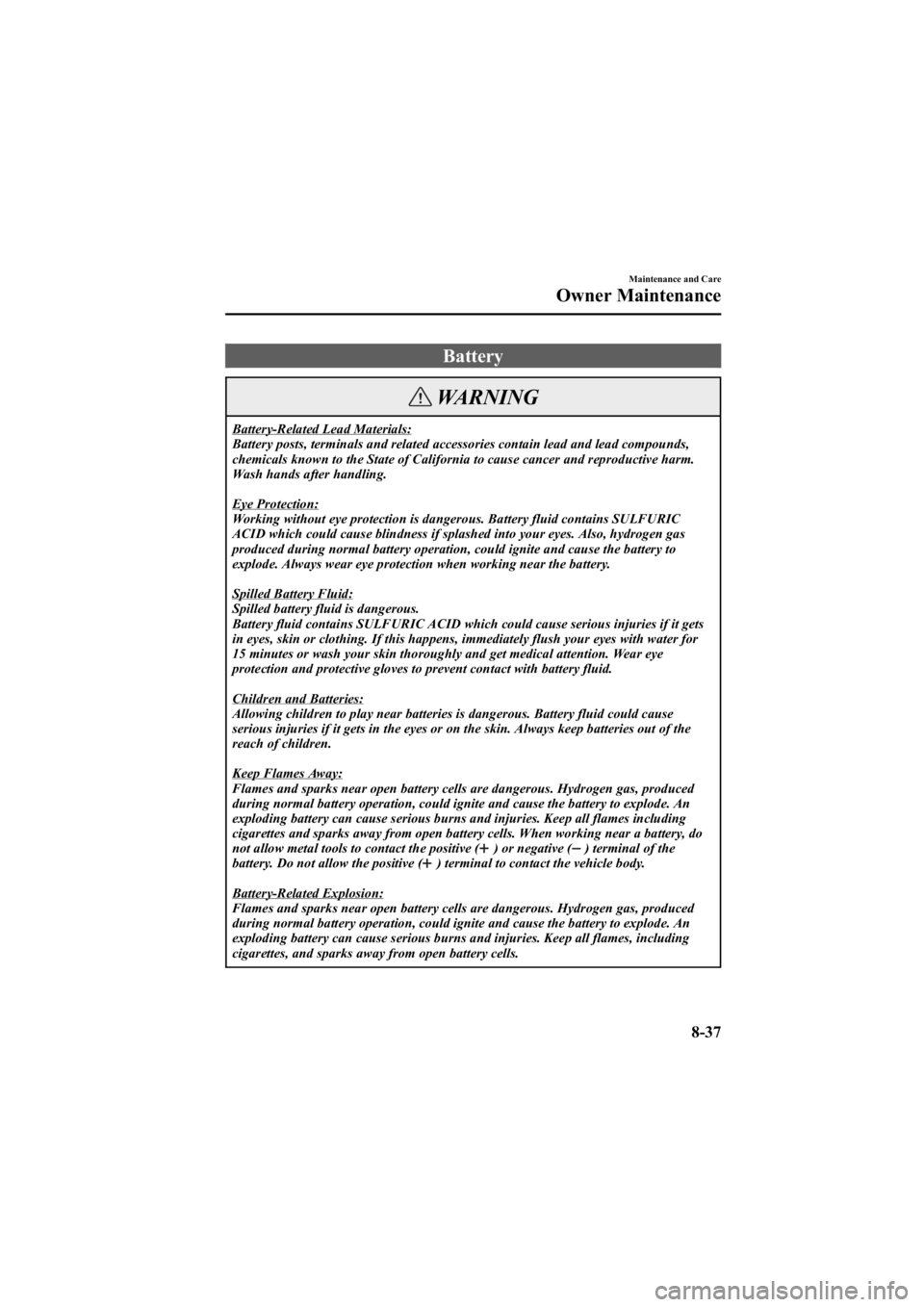
Black plate (303,1)
Battery
WARNING
Battery-Related Lead Materials:
Battery posts, terminals and related accessories contain lead and lead compounds,
chemicals known to the State of California to cause cancer and reproductive harm.
Wash hands after handling.
Eye Protection:
Working without eye protection is dangerous. Battery fluid contains SULFURIC
ACID which could cause blindness if splashed into your eyes. Also, hydrogen gas
produced during normal battery operation, could ignite and cause the battery to
explode. Always wear eye protection when working near the battery.
Spilled Battery Fluid:
Spilled battery fluid is dangerous.
Battery fluid contains SULFURIC ACID which could cause serious injuries if it gets
in eyes, skin or clothing. If this happens, immediately flush your eyes with water for
15 minutes or wash your skin thoroughly and get medical attention. Wear eye
protection and protective gloves to prevent contact with battery fluid.
Children and Batteries:
Allowing children to play near batteries is dangerous. Battery fluid could cause
serious injuries if it gets in the eyes or on the skin. Always keep batteries out of the
reach of children.
Keep Flames Away:
Flames and sparks near open battery cells are dangerous. Hydrogen gas, produced
during normal battery operation, could ignite and cause the battery to explode. An
exploding battery can cause serious burns and injuries. Keep all flames including
cigarettes and sparks away from open battery cells. When working near a battery, do
not allow metal tools to contact the positive (
) or negative () terminal of the
battery. Do not allow the positive () terminal to contact the vehicle body.
Battery-Related Explosion:
Flames and sparks near open battery cells are dangerous. Hydrogen gas, produced
during normal battery operation, could ignite and cause the battery to explode. An
exploding battery can cause serious burns and injuries. Keep all flames, including
cigarettes, and sparks away from open battery cells.
Maintenance and Care
Owner Maintenance
8-37
Mazda6_8V40-EA-05L_Edition1 Page303
Monday, November 28 2005 6:11 PM
Form No.8V40-EA-05L
Page 304 of 390
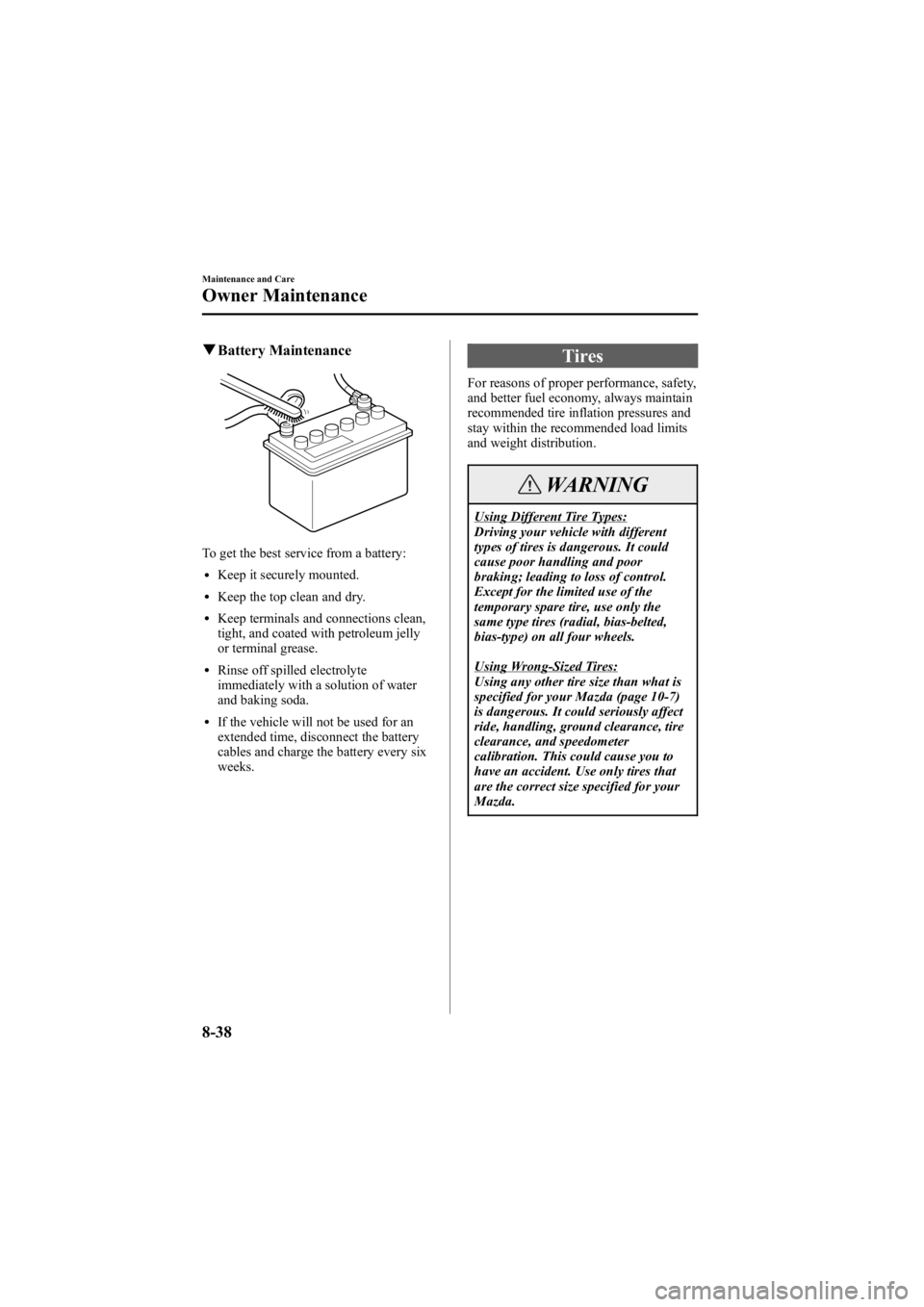
Black plate (304,1)
qBattery Maintenance
To get the best service from a battery:
lKeep it securely mounted.
lKeep the top clean and dry.
lKeep terminals and connections clean,
tight, and coated with petroleum jelly
or terminal grease.
lRinse off spilled electrolyte
immediately with a solution of water
and baking soda.
lIf the vehicle will not be used for an
extended time, disconnect the battery
cables and charge the battery every six
weeks.
Tires
For reasons of proper performance, safety,
and better fuel economy, always maintain
recommended tire inflation pressures and
stay within the recommended load limits
and weight distribution.
WARNING
Using Different Tire Types:
Driving your vehicle with different
types of tires is dangerous. It could
cause poor handling and poor
braking; leading to loss of control.
Except for the limited use of the
temporary spare tire, use only the
same type tires (radial, bias-belted,
bias-type) on all four wheels.
Using Wrong-Sized Tires:
Using any other tire size than what is
specified for your Mazda (page 10-7)
is dangerous. It could seriously affect
ride, handling, ground clearance, tire
clearance, and speedometer
calibration. This could cause you to
have an accident. Use only tires that
are the correct size specified for your
Mazda.
8-38
Maintenance and Care
Owner Maintenance
Mazda6_8V40-EA-05L_Edition1 Page304
Monday, November 28 2005 6:11 PM
Form No.8V40-EA-05L
Page 360 of 390
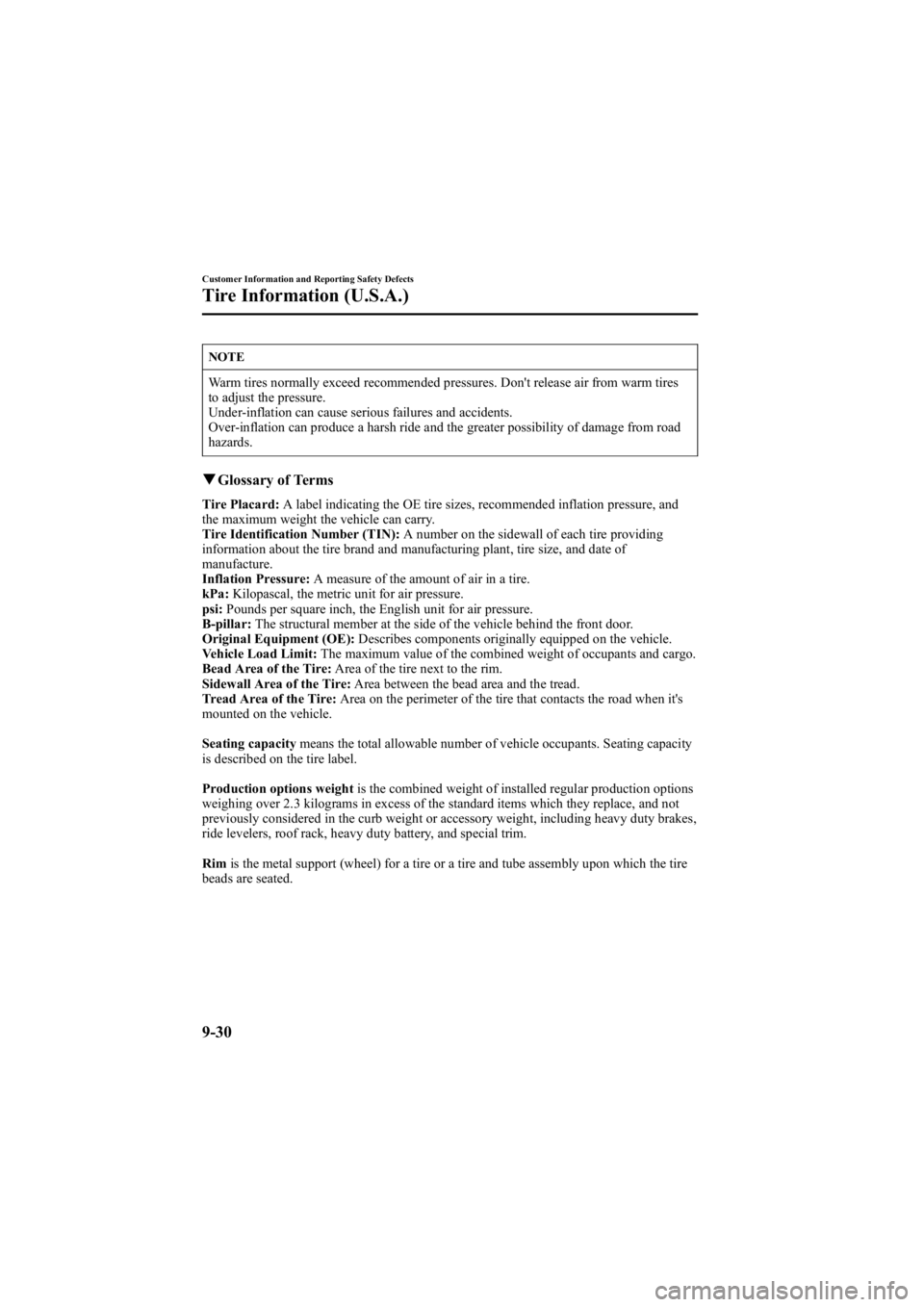
Black plate (360,1)
NOTE
Warm tires normally exceed recommended pressures. Don't release air from warm tires
to adjust the pressure.
Under-inflation can cause serious failures and accidents.
Over-inflation can produce a harsh ride and the greater possibility of damage from road
hazards.
qGlossary of Terms
Tire Placard: A label indicating the OE tire sizes, recommended inflation pressure, and
the maximum weight the vehicle can carry.
Tire Identification Number (TIN): A number on the sidewall of each tire providing
information about the tire brand and manufacturing plant, tire size, and date of
manufacture.
Inflation Pressure: A measure of the amount of air in a tire.
kPa: Kilopascal, the metric unit for air pressure.
psi: Pounds per square inch, the English unit for air pressure.
B-pillar: The structural member at the side of the vehicle behind the front door.
Original Equipment (OE): Describes components originally equipped on the vehicle.
Vehicle Load Limit: The maximum value of the combined weight of occupants and cargo.
Bead Area of the Tire: Area of the tire next to the rim.
Sidewall Area of the Tire: Area between the bead area and the tread.
Tread Area of the Tire: Area on the perimeter of the tire that contacts the road when it's
mounted on the vehicle.
Seating capacity means the total allowable number of vehicle occupants. Seating capacity
is described on the tire label.
Production options weight is the combined weight of installed regular production options
weighing over 2.3 kilograms in excess of the standard items which they replace, and not
previously considered in the curb weight or accessory weight, including heavy duty brakes,
ride levelers, roof rack, heavy duty battery, and special trim.
Rim is the metal support (wheel) for a tire or a tire and tube assembly upon which the tire
beads are seated.
9-30
Customer Information and Reporting Safety Defects
Tire Information (U.S.A.)
Mazda6_8V40-EA-05L_Edition1 Page360
Monday, November 28 2005 6:11 PM
Form No.8V40-EA-05L
Page 378 of 390

Black plate (378,1)
Specifications
qEngine
Item Specification
2.3-liter engine 3.0-liter engine
Type DOHC-16V in-line, 4-cylinder DOHC-24V 60°V, 6-cylinder
Bore×Stroke 87.5 × 94.0 mm (3.44 × 3.70 in) 89.0 × 79.5 mm (3.50 × 3.13 in)
Displacement 2,261 ml (2,261 cc, 137.9 cu in) 2,967 ml (2,967 cc, 181.0 cu in)
Compression ratio 9.7 10.0
q Electrical System
Item Classification
Battery 12V-50AH/5HR
Alternator 2.3-liter engine
12 V - 100 A
3.0-liter engine 12 V - 110 A
Starter 12 V - 1.4 kW
Spark-plug number 2.3-liter engine LFG1 18 110
*
L3Y2 18 110
3.0-liter engine AJ57 18 110*
Spark-plug gap 2.3-liter engine 1.25
―1.35 mm (0.049 ―0.053 in)
3.0-liter engine 1.29 ―1.45 mm (0.051 ―0.057 in)
* ex factory
q Lubricant Quality
Lubricant Classification
Engine oil Refer to the recommended SAE viscosity numbers
on page 8-18.
Manual transmission
oil 2.3-liter engine
Any temperature
API Service
GL-4 or GL-5
SAE 75W-90
Above 10°C (50°F) API Service
GL-4 or GL-5
SAE 80W-90
3.0-liter engine API Service
GL-4 or GL-5
SAE 75W-90
Automatic transaxle fluid 2.3-liter engine
ATF M-V
3.0-liter engine JWS3309
Power steering fluid ATF M-III, M-V, or equivalent (e.g. Dexron® III)
Brake fluid SAE J1703, or FMVSS116 DOT-3
10-4
Specifications
Mazda6_8V40-EA-05L_Edition1 Page378
Monday, November 28 2005 6:11 PM
Form No.8V40-EA-05L